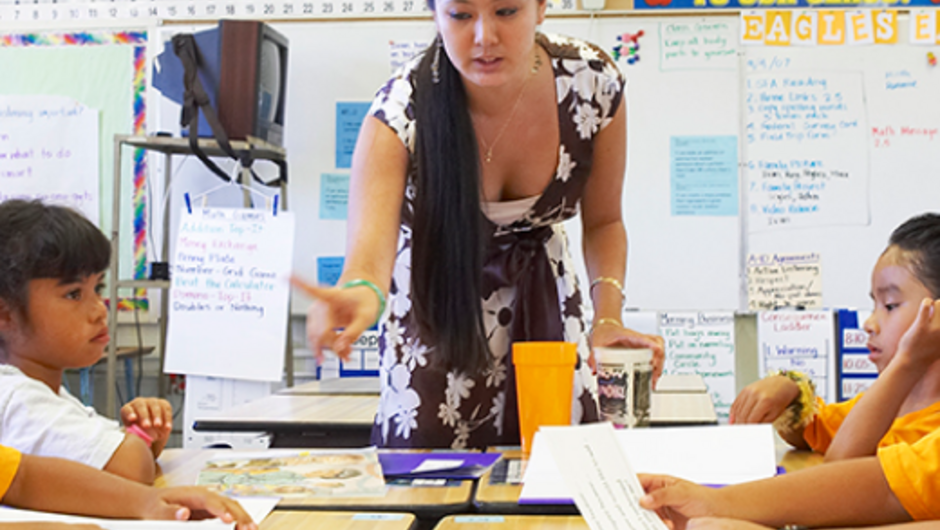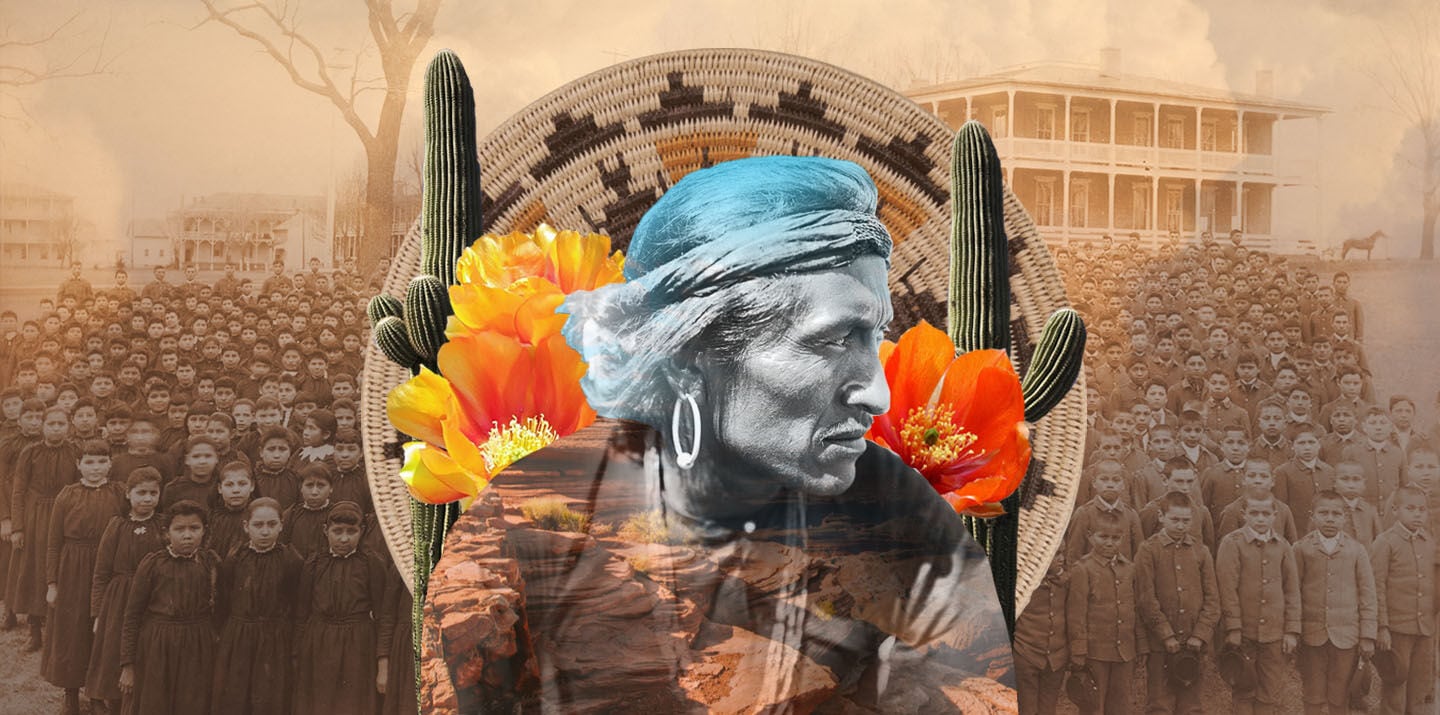
The U.S. Launched a War Against Indigenous Children. My Father Survived.
For more than a century, Native American children forced to attend boarding schools in the U.S. endured violence and a systematic attempt to eradicate their culture. This is one family’s story.
I sat in my urban Native vehicle of choice, the Subaru Forester, and gazed at the clock on the dashboard. I’d been sitting there for nearly 40 minutes unable to get myself to start the car. I recognized my reluctance; I’d been planning on talking with my dad about his experiences at a Native American boarding school in the 1960s, and I knew it was going to be emotional.
Out of a sense of responsibility, I tried to rationalize why I shouldn’t go through with the interview: How would my dad react? What if I somehow re-traumatize him with my "prying" questions? Mostly, though, I realized that those excuses were about me and how I felt more than anything he expressed to me. He had, after all, agreed to have this conversation. I turned the key and headed out to my parents’ home, the same place I grew up in suburban Salt Lake City, Utah, over 300 miles away from the Navajo reservation where my dad spent his early childhood.
What finally got me to start the car was this sense of responsibility I felt to share what my father would tell me. And not because what he experienced was entirely unique. His experiences fit in with those of other Native American boarding school survivors spanning place and time. For them personally, the boarding schools were places of trauma and pain. Institutionally, they were sites of cultural erasure and genocide.
Native American boarding schools sprung up in the United States in the late 19th century. Capt. Richard Pratt founded the first one that was not on a reservation, the Carlisle Indian Industrial School, in 1879 at a former military barracks in Pennsylvania. Its notoriety is such that Natives and scholars alike refer to it simply as “Carlisle.” The schools were based on a model of controlling all aspects of the student’s life within a military-like environment meant to break these children from their connections to their communities and themselves. Infamously, in response to the “Indian problem,” Pratt said:
“A great general has said that the only good Indian is a dead one, and that high sanction of his destruction has been an enormous factor in promoting Indian massacres. In a sense, I agree with the sentiment, but only in this: that all the Indian there is in the race should be dead. Kill the Indian in him, and save the man” (emphasis mine).
“Kill the Indian, Save the Man”
If the phrase sounds violent, it is. Ideologically, it was the idea of “Americanizing the Indian” to make him civilized. In practice, it was anything but civilized. The recent discoveries of hundreds of graves at residential schools in Canada (the equivalent to the American boarding schools) reflect the brutality and savagery that was enacted to “civilize.” Artifacts recovered from boarding school sites reveal the lengths this system would go to carry out its goal. Among them were weathered and worn shackles so little that they could only be worn by the smallest of school-aged children. Sickness and disease ran through these early schools leaving many dead, their bodies numbered in unmarked graves surrounding the schools.
Ronald Singer, my dad, entered the Tuba City Boarding School (TCBS) in Tuba City, Navajo Nation (Arizona) in the 1960s around age 7. Diseases weren’t the same kind of mortal threat that existed decades earlier, but the underlying logic of “killing the Indian to save the man” remained firmly in place. Upon arrival, he was issued clothing, basic living items, the boarding school haircut (replete with the patch of hair above the forehead that could be used as a handle to move the boys around), and inoculations.
“It’s not like any of them (the dorm mothers, dorm fathers, and nurses) treated us with kindness. They’d yell out, ‘Next!’ and push us in to get the shots. There was no one there to console us afterwards—no mom or dad there. We had to console ourselves,” my dad recalls. He lived in a dorm hall totaling about 40 boys. Their lives were completely regimented with set times for cleaning, bathing, eating, and playing.
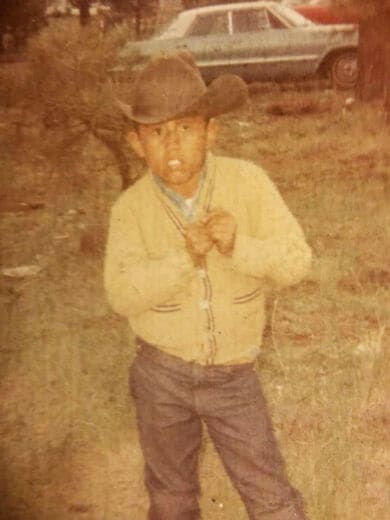
One of the first things they took away from the children was their language. They were forbidden from speaking Navajo. Failure to observe the rule would be met with physical punishment. My dad was lucky because he had learned English from tourists at the Grand Canyon where his mother worked. It also meant that he became the unofficial interpreter for the class. The teacher would instruct the students on something and my dad would explain to the rest of them what she was saying—at least until they began to understand and speak English themselves.
Language is a powerful part of humanity. Through it, we’re able to communicate abstract thought and travel across space and time. Navajo is an especially complex language. Not only does it employ the use of sounds that are difficult for English-speakers to reproduce, but the syntax, grammar, and other linguistic characteristics place it among the most difficult languages in the world. In an ironic twist, 20 years before my dad entered TCBS, the U.S. military used the Navajo language as the basis for a code in World War II—one that was never broken, though it would still be a few more years before the code was declassified and a couple of decades before the Navajo Code Talkers were formally recognized by former President Ronald Reagan for their vital part in the victory. In the meantime, these children were punished for uttering any phrase or word in Diné Bizaad—“the People’s Language.”
The tactic of systematically prohibiting language speaks to destroying the culture of a people. Without it, children would be unable to communicate with their grandparents and other family members. These relationships would weaken and the knowledge accumulated over millennia would not be passed on to the next generation. This practice proved so successful that it contributed to the extinction or endangerment of numerous Indigenous languages.
This gets at the heart of what anthropologist and historian Patrick Wolfe describes as “the logic of settler colonialism.” Settler colonialism is the academic term used to describe the system of oppression an imperial power or settler state employs over indigenous peoples. The logic of settler colonialism is that it must destroy in order to replace. The popularized phrase “kill the Indian, save the man” describes the sentiment, but it actually doesn’t do justice to the gravity of what settler colonialism is. The breadth extends across all aspects of social life.
In settler colonialism, nothing of the indigene is to remain—a necessary condition to establish a settler-colonial nation. The indigene must disappear by any means necessary and so too must any evidence of their culture, history, and civilization. Their lands must also undergo a transition as violent as the one wrought upon the individual.
What should establish our identity as Indigenous people, and our long-established connection to the land, are challenged under the logic of settler colonialism. To rescue the settler colonizer from this paradox, an identity consequently arises with the founding of the new settler state formed from those first settler colonizers. It is then that the settler colonizer lays claim to nativity; they make themselves into the new indigene.
It doesn’t matter that for hundreds of generations before me, my Indigenous ancestors lived, worked, played, loved, and died on this land—the claim to Indigenous authenticity no longer comes from how long we’ve been here on this land. It comes by tying oneself to those first settler colonizers. Settlers and their descendants boast about being a “true Utahn” (or Coloradoan, Montanan, etc.) because they are fourth, fifth, or sixth generation. They are supposedly more authentic and native, with a more legitimate claim to the land than Indigenous peoples, because they and their ancestors founded the new settler society. And because Indigenous peoples aren’t seen as an integral part of building that society, and may actually be portrayed as an existential threat to it, when many Indigenous peoples claim to have been here “since time immemorial,” before the idea of America ever having existed, the settler society further alienates and marginalizes them. “Yes, James, you may have had ancestors that have lived here for hundreds of generations,” they say, “but you’re only a first-generation Utahn.” My voice and my claims aren’t as valuable as theirs are.
For the vast majority of this country’s history, a national narrative justified the erasure of Indigenous peoples to make way for the establishment of the new settler-colonial regime. That narrative glosses over, or ignores completely, the means by which that erasure has come about: the theft and remodeling of Indigenous lands; the forced and often brutal marches Indigenous peoples endured to detainment camps; the scorched-earth military campaigns; the indiscriminate killing of men and women, the old and the young, the strong and the feeble; and the pervasive stealing of Indigenous children.
On the cultural side, it means Indigenous societies’ origin stories are reduced to “myths,” and the knowledge, philosophies, and life-ways developed over generations are reduced to out-of-context internet quotes or have been outright destroyed. Traditions are halted or outlawed. Language is forbidden. Clothing and food are altered. But most importantly, everything remaining that is indigenous must be undermined, trivialized, mocked, co-opted or rejected with the ultimate goal of eradication.
The American settler-colonizer makes us a foreigner in our own land. It is the settler-colonizer who becomes the ultimate authority in determining who even qualifies as Indigenous, what the Indigenous people are to be called (i.e. American Indians, Native Americans), and what makes an Indigenous person an authentic one. A real “Native American” must adhere to a narrow definition: be a “100 percent, full-blooded” person who practices the traditions and speaks the language. They must resemble as closely as possible the “Indian” the colonizers encountered at first contact. A Native American, by this definition, is to be a living artifact from a static past, existing in a curious state that borders on being reduced to a museum exhibit.
Settler-colonizers wage campaigns of genocide, from mass murder to the ongoing erasure of history and culture. Genocide, the deliberate destruction of a group of people from a particular nation or ethnicity, was outlawed in the international community in the 1940s after the creation of the United Nations and the atrocious and mechanized acts of death perpetrated by Nazi Germany. Yet even after this human milestone, the United States continued an official policy of “Indian termination” that spanned over three decades in the mid-20th century, characterized by pursuing acts of cultural genocide and the coerced assimilation of Natives into mainstream American society.
The federal government’s set of termination policies meant, in some cases, no longer recognizing the sovereignty of a particular tribe. Unilaterally, the U.S. government ended the special relationship between itself and that particular tribal nation. It also meant that the U.S. government would no longer honor any of its obligations toward these specific nations. Additionally, it opened Native American lands the U.S. government held in trust to anyone from American society legally allowed to own land. It essentially stripped people of their group identity and produced newly minted individual Americans, now without any ties to their homelands.
Cultural genocide breaks up a community by eliminating all traces of group identity -- only individuals remain. Without the group and its culture, individuals are left unfettered and vulnerable. And because culture is intrinsically social, created and reinforced by social interactions, an individual alone cannot be a culture. There is no such thing as a culture of one.
They Were Just Children
“It was humiliating,” my father said of the punishment at TCBS. “They’d line us all up and the boy who got in trouble would have to pull his pants and underwear down to his ankles and crawl between the legs of all of us in the line. We had to spank him as he passed through.”
This kind of routine punishment was a mind game—a way to interrupt social connections and induce psychological trauma. Again, “killing the Indian,” breaking him down to build someone new—an American.
It’s at this point in our conversation that I’m having a difficult time understanding the reality of what my dad is sharing. He was so young, and he was thrown into such a cruel environment.
“We were scared. I don’t think any one of us enjoyed hurting each other. Because we knew we could be in his shoes—that could be us,” he said. I asked him how often this would happen. “Oh, a couple times a week,” he answered.
I asked him what would happen if they didn’t participate. “We’d be forced to go through then too. The dorm mother or dorm father would be watching us to make sure we weren’t hitting too lightly. Meanwhile, the kid would be crying as he’s going through,” he explained.
In another jarring experience, my dad noticed a group of boys who had gathered together and went over to investigate. There he saw one of the dorm mothers with her back to the boys. She bent over and lifted up her skirt to expose her genitals. Then she looked back at them and coyly smiled.
“That affected me,” he said. An understatement if I’ve ever heard one. This experience, and others like it, was something my dad learned to block out—only to resurface years later as an adult while working through his post-traumatic stress.
On weekends, most parents or adult family members would arrive at the school and check their children out and take them home. My dad recalls that his parents rarely picked him up.
I noticed a change in my father’s countenance as he remembered this memory. It was almost as if for a moment he was actually reliving it. He’d watch the boys get picked up and he patiently waited, hoping that his turn would come. He’d feel disappointment when they never came—then puzzlement and finally resignation. Over time, my father built up emotional barriers to avoid having to be constantly let down. “We all had to grow up very fast,” he said.
As my dad recounts these experiences as a young boy in boarding school, I’m overcome with confusion. The whole thing seems so foreign to me. I’ve never experienced prolonged exposure to a stressful environment that consistently conjured up the fight or flight response nor have I constantly lived life in survival mode. And all of this happened to him in those tender, formative years of early development. The trauma induced has long-lasting effects, not only for the individual but for an entire generation of people and their children.
I look over at my daughter who’s 5 and about to start kindergarten as she enters the room where my dad and I are talking. She’s smiling and looks over at me, and I see my dad in her face. I start to tear up, and a few run down my cheeks. My mind keeps repeating: They were children, just kids.
The Shame of a Nation
The simple fact is the U.S. government used its full power and force to eradicate the lives of children. The main target was the dissolution of the Indigenous family structure. By hollowing out a generation of its potential, it became far easier for the occupying force to dispense with their prey however they wished. The United States was fighting a war against children.
The extent to which this internal destruction makes itself manifest is evident in the inability for now-grown adults to express basic but powerful emotions such as love. The effects boarding school had on my grandparents and my father meant that they rarely expressed their love for each other. My father recalls that he never once heard his own father tell him, “I love you, son.”
The inability to express emotion displayed itself when my dad was a parent, too. When his children turned 6 or 7, about the age my father entered boarding school, he detached himself from us and didn’t even realize it. The involvement and displays of affection that are so easy to extend to children petered out. Even to this day, my dad experiences difficulty expressing love toward his now-grown children. I’ve rarely heard my father tell me he loves me, and when trying to exchange hugs, he may initially recoil only to reluctantly agree to a brief and awkward side hug. I know he does love me. It’s been evident in his actions over many years. But sometimes it was just hard.
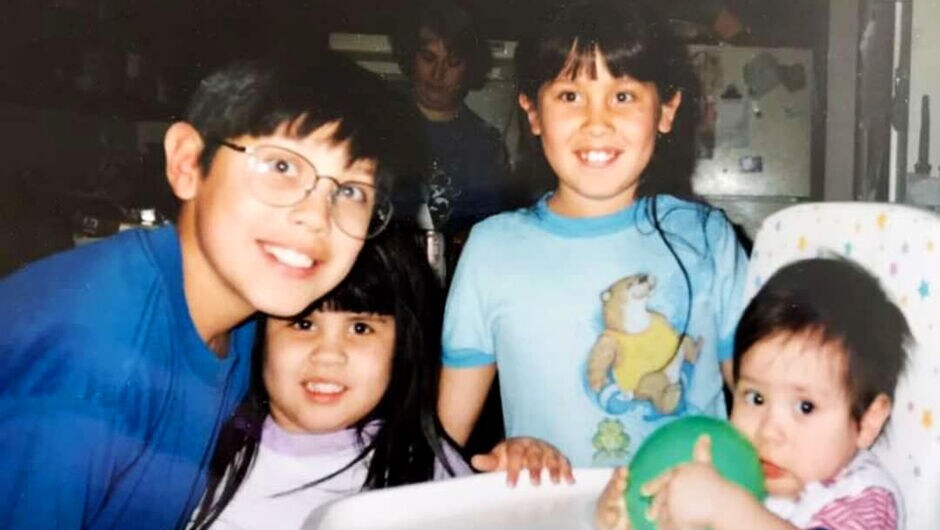
I don’t blame my dad. Maybe when I was younger I harbored some resentment, but even then I contemplated that something else was going on. Something bigger than what I could comprehend. Even now, as I approach 40 years of age, I still don’t believe I can ever fathom what he must have experienced.
My two daughters, though a little younger than my dad was when he entered boarding school, are all I can think about, and I am filled with immense sadness and even rage that my beautiful little girls and all the values I’ve tried to instill in them would have been subjected to a powerful institution whose mission was to destroy everything about them and replace it with so-called “civilization.”
This Is Civilization?
I believe you can tell a lot about a society and its people by how they treat their most vulnerable. How do they care for children and the elderly? How do they interact with those who have nothing or very little? How do they treat animals, plants, and ecosystems? What do they consider to be sacred?
American civilization is young. It’s riddled with contradictions and betrays itself often. In the U.S., the individual is so valued that personal freedom jeopardizes the common good. The wisdom of elders is mocked. People are supposed to do everything they can to appear young—spending lavishly on surgical procedures, gym memberships, and beauty products. Children are socialized to become obedient, docile employees. So much human potential is left untapped because of our society’s inability to see the intersection of history, larger social forces, and the individual. And though it’s the wealthiest nation in the world, millions of people in the U.S. experience food insecurity, unemployment, poverty, homelessness, and expensive healthcare. The religion is consumerism and what is sacred above all else is private property. Self-interest is the logic and competition is the basis for social relations. Energy independence, economic development, and national security justify an ever-expanding economic regime that has life on this planet perched in a very precarious position. This is civilization.
While civilization has brought about technological innovation and everyday comforts, those advancements have come at an enormous cost socially, individually, and ecologically. And material comforts are so poorly distributed that it makes sense Indigenous elders warn us to be aware of being seduced by consumerism. The machine eats Indigenous people alive, and the promise of the “American Dream” is more myth than fact and more nightmare than dream. This is the civilization that’s offered to us. America has broken individual Natives and broken Indigenous societies to convince us that this way of life is the best and yet, ironically, it is rarely attainable.
None of this is tangential—it is the rationale behind why the boarding school system was instituted in the first place. The purpose of boarding schools was to destroy everything that made us who we were and convince us that they were actually offering us something better.
Resilience and Recognition
After a couple of hours near the end of our conversation, I asked my father what he’d like people to know or do.
“Recognize what happened,” he said. “It did happen. And people should know it did. And that we survivors are resilient.”
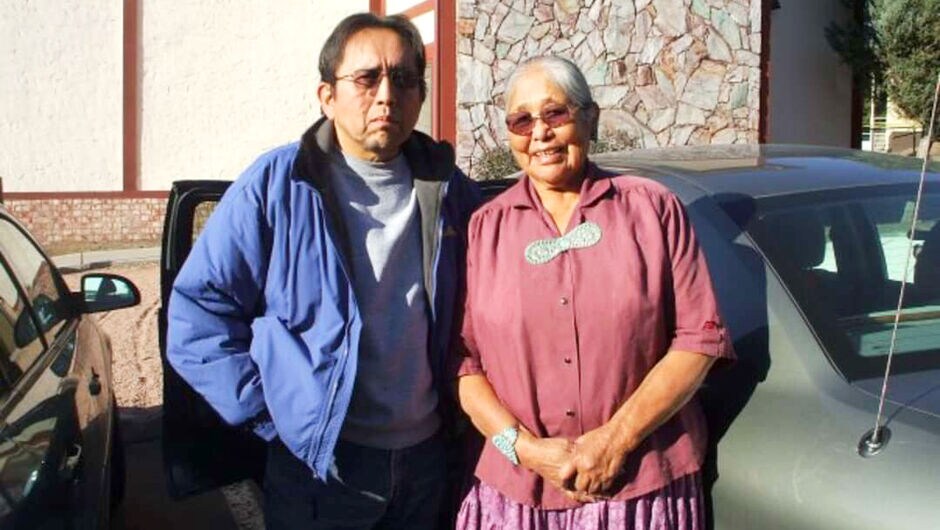
My father is resilience. The fact he is alive is resilience. That he can speak the Navajo language is resilience. That he raised his children to be proud of their heritage is resilience. Boarding school may have broken my father in many ways, but it was never totally triumphant. In the end, it failed to take away what it sought most: his spirit, his identity, and his strength.
Luckily, many other survivors of Native American boarding schools learned resilience. They became an embodiment of resilience. It didn’t mean that they left unscathed. The mental and emotional trauma boarding school survivors still experience, the physical and spiritual trauma they continue to endure—those are the lasting effects of this settler-colonial project and ones this nation still needs to recognize and reconcile.
Editor’s Note: In the 19th and 20th centuries, hundreds of thousands of Indigenous children were separated from their families and put in U.S. government-funded boarding schools that operated across more than two dozen states. The U.S. is now in the midst of a national reckoning about the dark legacy of abuse and cultural erasure at these schools. At the same time, many boarding school survivors, including Ronald Singer, are telling their stories about the trauma they experienced at the schools.
In June 2021 , the U.S. Interior Department announced the Federal Indian Boarding Schools Initiative, an investigation into the troubled history of the schools. (Department Secretary Deb Haaland—the first Native American cabinet secretary—wrote about her family’s personal trauma from them in a commentary in The Washington Post.) The department continues to operate residential boarding schools, including the Tuba City Boarding School, through the Bureau of Indian Education. According to the department, these schools now aim to provide an empowering education to Indigenous students as they seek to learn their language and embrace their culture.
James Courage Singer is an assistant professor of sociology and ethnic studies at Salt Lake Community College in Salt Lake City, Utah. He is Diné (Navajo) and a member of the Navajo Nation. His community work and research interests are in race/racism, Native American issues, social mobility, and politics.
We want to hear your opinions! To submit an idea for an Opinion piece or offer feedback on this story, visit our Suggestion Box.
Sign up to receive articles like this in your inbox!
Thanks for signing up!
Content is loading...




